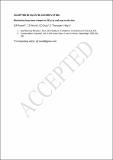Files in this item
Monitoring long-term changes in UK grey seal pup production
Item metadata
| dc.contributor.author | Russell, Debbie J. F. | |
| dc.contributor.author | Morris, Chris D. | |
| dc.contributor.author | Duck, Callan D. | |
| dc.contributor.author | Thompson, Dave | |
| dc.contributor.author | Hiby, Lex | |
| dc.date.accessioned | 2020-09-05T23:35:03Z | |
| dc.date.available | 2020-09-05T23:35:03Z | |
| dc.date.issued | 2019-09-06 | |
| dc.identifier | 261123674 | |
| dc.identifier | e82b1700-69cd-4cd9-8321-c543d38ceba2 | |
| dc.identifier | 85071754340 | |
| dc.identifier | 000484997200003 | |
| dc.identifier.citation | Russell , D J F , Morris , C D , Duck , C D , Thompson , D & Hiby , L 2019 , ' Monitoring long-term changes in UK grey seal pup production ' , Aquatic Conservation: Marine and Freshwater Ecosystems , vol. 29 , no. S1 , pp. 24-39 . https://doi.org/10.1002/aqc.3100 | en |
| dc.identifier.issn | 1052-7613 | |
| dc.identifier.other | RIS: urn:7DFC7D399B46A336AE5834B9A44720DD | |
| dc.identifier.other | ORCID: /0000-0002-1969-102X/work/61622003 | |
| dc.identifier.other | ORCID: /0000-0003-1546-2876/work/61622045 | |
| dc.identifier.uri | https://hdl.handle.net/10023/20562 | |
| dc.description | The work was supported by funding from the Natural Environment Research Council to SMRU (grant no. SMRU1001). | en |
| dc.description.abstract | 1. The population size of many species, particularly those in the aquatic environment, cannot be censused directly. Counts, during the breeding season, of one component of the population (e.g. breeding females) are often used as an index to allow investigation of trends. In species, such as grey seals (Halichoerus grypus), for which births are not tightly synchronous, single counts of pups represent an unknown proportion of the total number of pups born (pup production), and thus of breeding females (i.e. each pup born represents a breeding female). 2. Grey seals pup at large colonies around the coast of the UK. Information on their populations is required under national and international legislation. 3. In the UK, pup production has been monitored at some colonies since 1956. Currently, large colonies (~90% of UK pup production) are monitored either using ground (~10%; annually) or aerial surveys (~80%; annually until 2010, and thereafter biennially). 4. Here, the model used to estimate pup production at aerially surveyed colonies from 1987 to 2010 is described; structured pup counts from multiple surveys are combined with knowledge of life‐history parameters to model birth curves. 5. The resulting trends in pup production up to 2010 (aerially surveyed colonies) and 2016 (ground surveyed colonies) are examined. 6. In 2010, over 45,000 pups were estimated to be born in the UK. Pup production appeared to have reached an asymptote in the Inner Hebrides, Outer Hebrides and Orkney, whereas it is still increasing exponentially in the North Sea. Although density‐dependent processes acting at sea are likely to be responsible for these regional trends, we suggest that the substantial variation in trends within regions are likely caused by processes acting at the colony level. Some long‐established colonies, including Special Areas of Conservation, are exhibiting decreasing trends. 7. Special Areas of Conservation often serve as de facto monitoring sites and are the focus of management efforts. The observed temporal and spatial variability in patterns of colony growth rates highlight the potential risks of using such sites to develop wider management policies. | |
| dc.format.extent | 16 | |
| dc.format.extent | 893632 | |
| dc.language.iso | eng | |
| dc.relation.ispartof | Aquatic Conservation: Marine and Freshwater Ecosystems | en |
| dc.subject | Conspecific-attraction hypothesis | en |
| dc.subject | Density-dependent survival | en |
| dc.subject | Local population dynamics | en |
| dc.subject | Metapopulations | en |
| dc.subject | Long-term monitoring | en |
| dc.subject | Natal dispersal | en |
| dc.subject | Pinnipeds | en |
| dc.subject | Recruiter-attraction hypothesis | en |
| dc.subject | GC Oceanography | en |
| dc.subject | QH301 Biology | en |
| dc.subject | NDAS | en |
| dc.subject.lcc | GC | en |
| dc.subject.lcc | QH301 | en |
| dc.title | Monitoring long-term changes in UK grey seal pup production | en |
| dc.type | Journal article | en |
| dc.contributor.institution | University of St Andrews. School of Biology | en |
| dc.contributor.institution | University of St Andrews. Sea Mammal Research Unit | en |
| dc.contributor.institution | University of St Andrews. Scottish Oceans Institute | en |
| dc.contributor.institution | University of St Andrews. Centre for Research into Ecological & Environmental Modelling | en |
| dc.contributor.institution | University of St Andrews. Marine Alliance for Science & Technology Scotland | en |
| dc.identifier.doi | https://doi.org/10.1002/aqc.3100 | |
| dc.description.status | Peer reviewed | en |
| dc.date.embargoedUntil | 2020-09-06 |
This item appears in the following Collection(s)
Items in the St Andrews Research Repository are protected by copyright, with all rights reserved, unless otherwise indicated.

